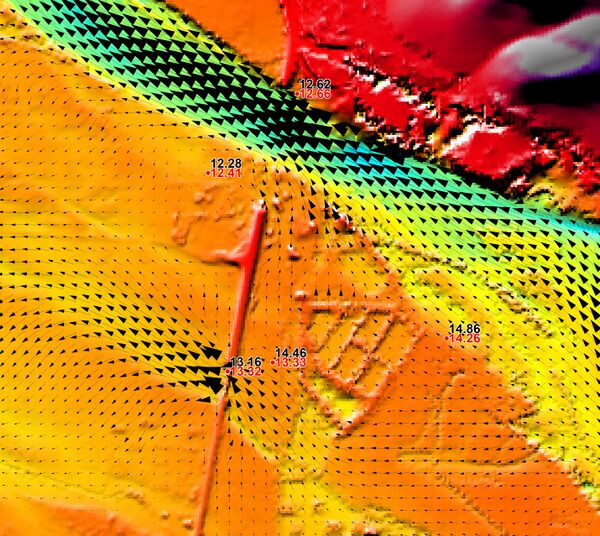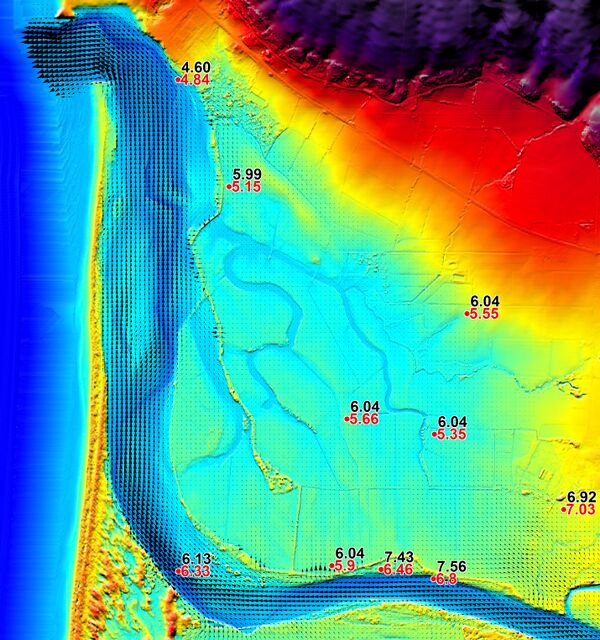FMA Challenge 2
Introduction
If you haven't already completed FMA Challenge 1, please see this FMA Challenge 1 page. This page is for TUFLOW users of intermediate to advanced ability.
In this challenge, a tidally influenced floodplain and riverine system will be explored along the California Coast. More information is available in the "tidal-description.docx" in the ZIP compressed file provided.
From this challenge, it is expected the user will develop their skills in:
- Understanding tidal influences on floodplains and riverine systems,
- Influence of cell resolution on results and whether or not the model should contain a 1D component;
- Using a looped batch file to run through scenarios;
- Understanding comparisons between three different 2D solvers. These include TUFLOW classic, TUFLOW GPU and TUFLOW FV.
Data for this model is provided via ZIP compressed file posted on the internet/FTP for download.
Relevant Tutorials
It may be useful to revisit some of the following tutorials:
- General 2D modelling- Tutorial Module 1
- 2D topography modification- Tutorial Module 3
Information to Modelers
Assignment of all parameters for this analysis are at the discretion of the modeler. A high resolution aerial image is provided so that land cover details can be inspected. Information on the problem definition can be found on FMA_Challenge_Models/FMA_Scenario2/FMA_Challenge_Model_Introductions.
Relevant Files
It is up to the modeler's discretion to determine what GIS package to use, what text editor to use, and how to run their models (batch mode or within the text editor).All relevant files can be found on FMA_Challenge_Models/FMA_Scenario2/
Solution
A sample solution has been presented, courtesy of BMT WBM.
Cross section spacing, Grid Size, and Mesh Element Size
Fixed grid models of different resolutions and a flexible mesh model were set up. The fixed grid domains were orientated north-south.
The coarsest fixed grid and flexible mesh resolutions were sufficiently detailed to represent the river bathymetry, so no 1D/2D coupling was incorporated. A fully 2D solution is preferable over a 1D/2D linked representation provided the 2D resolution of the primary flowpaths is sufficiently fine. A minimum recommended 2D resolution across the river for TUFLOW for this model is a 30m grid (it is recommended that a minimum of 4 fixed grid cells be used for modeling a primary flowpath). For this model the upper sections near the two inflows are not represented well, especially the northern Tributary Inflow. However, this is unlikely to have an adverse effect on the objectives of the modeling, but would affect the comparison to the high water marks near these inflows.
As there is no 1D/2D linking, Challenge 2 provided an opportunity to provide some comparisons between our three different 2D solvers. Results from TUFLOW (finite difference implicit solution), TUFLOW’s GPU Module (explicit finite volume GPU solver over a grid), and TUFLOW FV (explicit finite volume flexible mesh) are presented.
The number of cross sections, grids, or mesh elements used were as follows:
| 2D Domain | Active 2D Cells/Elements |
|---|---|
| 10m (grid) | 727, 865 |
| 15m (grid) | 323, 364 |
| 30m (grid) | 80, 842 |
| FM (Flexible Mesh)* | 17, 479 |
N.B. For the FM (Flexible Mesh) within the main flow channels the typical element width is 20 m and length 50 m (quadrilateral elements), and on the floodplains the typical size is 75 m to 100 m made up of quadrilaterals and triangles.
Computational Domain Assembly and Execution
TUFLOW Fixed Grid Model
The TUFLOW model directly reads the provided ESRII ASCII DEM raster format, to set the extent of the computational domain and interpolate elevations at the 2D cell centers, mid-sides and corners. The boundary locations were digitized in GIS layers. The provided GIS land use layer was directly read for assigning roughness values.
Simulation results were viewed using SMS and GIS software. Calibration high water marks were loaded into a GIS layer and displayed within the GIS mapping to easily view the calibration performance of the model. TUFLOW’s 3D surfaces of peak water levels and depths were imported into the GIS to generate flood extent outlines.
TUFLOW FV Flexible Mesh Model
The approach taken to develop the TUFLOW FV Flexible Mesh model was:
- Using the SMS software with DEM shaded contours as a guide, develop mesh map (creating polygons of specific areas in the model that had a specific mesh design and resolution). The design was such that elements follow bathymetric contours and likely flow directions. Also ensure that narrow flow channels are well resolved and elements lie along center of flow channel.
- Create mesh, automatically generating geometry (z) values from the DEM.
- Setup input files, consisting of one input file and 3 boundary condition time series (csv files).
- Run simulation on Dell Laptop 64 bit Intel i7 2.8 GHz CPU.
- Several simulations performed with varying Manning’s friction applied.
- Within SMS, load shape file with high water marks and point inspect model results of maximum water level. Export to Excel, convert to feet.
- Export 3D water level and depth surfaces into GIS to produce maximum flood extent polygons.
Discussion on Calibration
A limited number of simulations were carried out to develop an understanding of the flood behavior and sensitivity of varying parameters. The results of these simulations are discussed below, some of which are provided in the ftp download.
Simple Manning’s n / Topography Test
The initial runs were carried out using the same Manning’s n over the entire model over a coarse resolution grid and flexible mesh. These runs were carried out using TUFLOW and TUFLOW GPU (30m grid), and TUFLOW FV (flexible mesh) models.
The topography for these runs did not include any special provision for incorporating the levee and road embankments. The elevation sampling of the DEM was simply based on inspecting the DEM at the models’ elevation points. At this stage no 3D breaklines along the embankment crests were used to ensure the crest of the elevation was correctly represented by the models’ elevations.
The Manning’s n used for the results provided was 0.035, which seems to give a reasonable first pass reproduction of the high water marks. A value of 0.035 is consistent with the global n value that would typically apply to this study area.
Also of interest is the comparison between the three different 2D solvers TUFLOW, TUFLOW’s GPU Module and TUFLOW FV (all three use a different solution technique). There is generally good agreement between all three schemes.
A high resolution .jpg image is provided in the ftp downloads for viewing the HWMs and results of these three simulations. Open “Images\FMA C2.n0.035.HWM All 2D Solvers.jpg” and zoom in and pan around to easily view the flow patterns (velocity arrows), water level contours every 0.2m (blue lines), depths (blue shading) and high water marks (red is the recorded value, light blue is TUFLOW, black is TUFLOW GPU and yellow is TUFLOW FV).
NLCD Land Cover and Embankment Crests Included
Additional simulations were carried out using TUFLOW that included the NLCD Land Cover GIS layer, and 3D breaklines of the levee and road embankments visible in the DEM and aerial photo. This scenario (we envisage) would probably be representative of the present day conditions, and not representative of the 1964 flood event conditions.
The NLCD GIS layer was read directly by TUFLOW and Manning’s n values assigned to the different land covers as tabulated below. The water/river n value of 0.02 is considered at the lower end of typical n values for rivers based on numerous 2D model calibrations. Typically for the lower reaches of coastal rivers the in-bank n value is 0.022 to 0.025 with an acceptable range considered to be (0.02 to 0.03). In upper reaches, away from tidal influences, n values tend to be higher (0.025 to 0.04) for perennial rivers. Possible reasons for the low n value could be due to the river bathymetry accreting since 1964 (we assume the bathymetry provided is based on more recent surveys), or the inflows maybe high.
The n values used are presented in the table below:
| Material ID | Manning's n | Description |
|---|---|---|
| 11 | 0.04 | Dummy Open Water - Overwritten by digitised polygon |
| 21 | 0.05 | Developed |
| 22 | 0.08 | Developed |
| 23 | 0.1 | Developed |
| 24 | 0.2 | Developed |
| 31 | Barren Land(Rock/Sand/Clay) | |
| 41 | 0.05 | Deciduous Forest |
| 42 | 0.05 | Evergreen Forest |
| 43 | 0.06 | Unknown |
| 52 | 0.1 | Shrub/Scrub |
| 71 | 0.1 | Grassland/Herbaceous |
| 81 | 0.04 | Pasture/Hay |
| 82 | 0.05 | Cultivated Crops |
| 90 | 0.1 | Woody Wetlands |
| 95 | 0.1 | Emergent Herbaceous Wetlands |
| 101 | 0.02 | Water/Sand/Silt |
The NLCD land cover provided a poor representation of the in-bank river section when compared with the DEM and aerial photography. The river section was therefore digitized to replace the NLCD representation in the river. A general comment overall was that the NLCD land cover was not always in agreement with the aerial photo and somewhat poor in its accuracy and resolution.
For the levee and road crests, GIS breaklines were digitized along the crests, and elevations sampled from the DEM. Ideally, ground surveys of these hydraulic controls would be available to ensure the crest is accurately modeled. TUFLOW reads the GIS breaklines and interpolates the crest elevation to the nearest 2D cell elevations to ensure the embankment height is correctly modeled.
In general the comparison with the high water marks tends to be higher overall, but the distribution of flow has improved with less water travelling to the southern tidal entrance. In a few areas it is worse such as in the images below. In the images the red values are the 1964 HWMs, and the black the calculated peak levels. In these areas the presence of the embankments has a strong influence on the calibration results. To test this influence a further scenario removing two critical embankments was carried out as discussed further below.
Removal of Major Embankments Scenario
To test the effect of completely removing the embankments in the images above, the 15m and 30m TUFLOW models were used. Initially the 30m model was run as this is a quick running model so good for an initial sensitivity tests.
The embankments were removed by digitizing the polygons shown in grey in the images below, and using TUFLOW’s Z Shape functionality that creates TINs within the polygons whose perimeters are merged with the surrounding ground levels to erase the embankments. This is a very quick process to do and setup (about 5 minutes in this case), and there is no need to rework the original DEM.
The images below for the initial 30m grid run show the levels at the high water marks with and without the embankments at the two locations previously discussed. The red values are the 1964 HWMs, the blue values the without embankments scenario and the black values in brackets for the with embankments case previously discussed. An improvement in the calibration results tends to result.
The 15m simulation provided an even better calibration, and gives the best overall performance of all simulations carried out. The maximum flood extent layer is provided in the ftp download for this simulation.
In conclusion, we would surmise that some of the key embankments within the study area either did not exist at the time of the 1964 event or were of a lower height or configuration.

